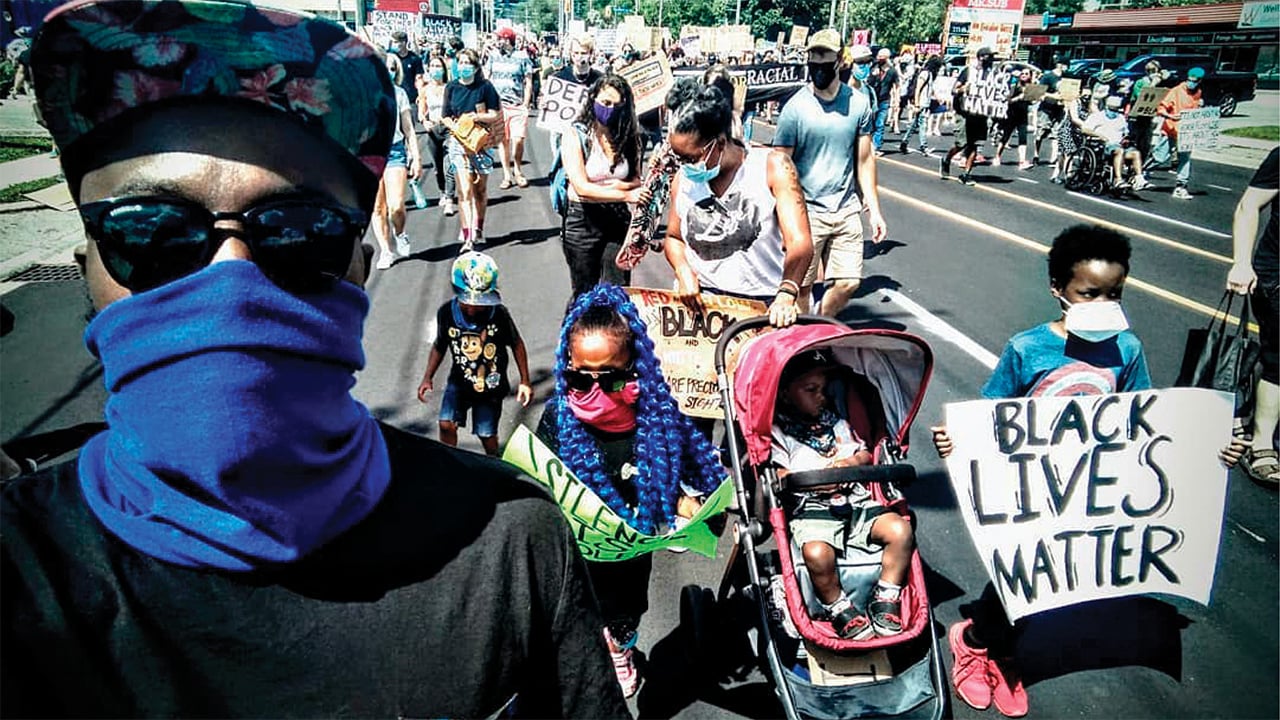Making a sign, showing up and taking a stand for your beliefs is one way to show your kids and your community what anti-racism work looks like.
When George Floyd’s senseless murder was broadcast around the world, Tara Watts, a Toronto-area single mother of three, was watching. With a 10-year-old daughter and two sons, ages seven and four, Watts’s next course of action was clear. And that action would involve her children.
Within two days, they had attended two demonstrations against injustice. “That was their first experience ever doing a march or a protest,” she says. The decision to take them was rooted in Watts’s own personal experience as a Black woman. She wasn’t particularly worried about safety because, she says, “There’s no scenario where a Black person is safe—walking, sleeping or driving. Going to a protest with my kids doesn’t increase the chances of something happening to them.”
Promise Shepherd and his wife, Liya, have also made the choice to bring their young children to an anti-Black racism demonstration. The Black couple from Acton, Ont., brought all four of their kids after their oldest son, who is nine, started asking questions about recent events. “He was being affected by all of the information he was hearing about Black lives being taken,” says Shepherd. “We wanted to be able to look back and remember that we did something about the problem of racism together, as a family.”
While Black families may have a level of personal experience tied to racism and police brutality, this doesn’t exclude white families and other families of colour from being moved to action. Everyone is angry (and should be), yet it can be intimidating to decide to attend a public protest. You know it’s important to be an ally, but you’re also wondering, where do we begin? And is it dangerous—especially during the COVID-19 pandemic?
The organization Showing Up for Racial Justice (SURJ) is one place to start. It has a network of chapters across North America, and its mandate is specifically to help white people battle racial injustice caused by white supremacy. For the Toronto chapter, this includes redistributing resources to support BIPOC-led movements and participating in actions and campaigns, such as phone blasts to defund the police. “We believe that white people have a role to play in dismantling white supremacy because it’s a structure that relies on our complicity or support,” says Johanna Lewis, co-founder of SURJ Toronto. “In the SURJ Kids and Families team, we also work to build and share skills to challenge racism when it shows up in our schools, families or wider communities.”
Lewis has been taking her two kids, ages two and six, to demonstrations since they were babies. “Attending rallies is just a regular part of our family life,” she says. “As a white parent of white kids, I have a responsibility to raise my kids in a way that challenges the default racism and white normativity of wider society.” But she understands parents’ trepidation and anxiety, especially with media coverage showing frightening scenes and police violence.
“Most protests will have marshals, medics, legal support and liaisons to keep participants safe,” she says. “Often they will wear vests, armbands or hats to designate themselves. They’re good people to turn to with questions or for support.”
When determining if an event will be safe for families, Lewis recommends parents research the organizers and activists beforehand. Have they held protests before? Does the event seem well organized with clear information? Are families and children called out as being welcome? Lewis’s own way of assessing any threat is a quick scan of the crowd. “The main thing I am looking for is a large or aggressive police presence, especially if they outnumber protesters.” (A large police presence can mean that they are preparing for violence.)
Check to see what measures are being taken to reduce the risk of COVID-19 transmission, including physical distancing and mask-wearing. Parents should trust their instincts, says Lewis. “Leave if things get heated.”
For Watts, the benefits far outweighed the risks. “My children saw the power of standing up together, the importance of being vocal and how much support is out there, if you just look and listen,” she says. “What I want people to know is that when we unite, nothing stands in our way.”
